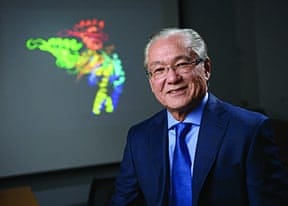As the Nobel Prize ceremony held this month in Stockholm recognized 3 researchers for circadian rhythms discoveries, Joseph S. Takahashi, PhD, a researcher utilized the Nobel Prize-winning discoveries in his own work, marvels at how far the field has come and the potential to translate its findings into life-saving medical breakthroughs.
Much of that success will stem from a cascade of findings related to the CLOCK gene, the first mammalian gene controlling circadian rhythms, predicts Takahashi, who discovered and cloned the gene the 1990s. Subsequent research has established CLOCK as a prominent regulator of other biological clock genes and a key target to better understand the primary underpinnings of human nature.
“It has been rewarding to see how the CLOCK gene pathway impacts so many areas of biological function and their impact on biomedicine,” says Takahashi, Chairman of Neuroscience at UT Southwestern Medical Center’s Peter O’Donnell Jr. Brain Institute, in a release. “Our field is just beginning to understand the significance of CLOCK and its application to cancer, mental health, and other conditions.”
From Flies to Mammals
In the 1970s, Seymour Benzer, PhD, and Ronald Konopka, PhD, discovered through genetic screening fruit fly mutants with abnormal hatching rhythms.
Three other scientists won this year’s Nobel Prize for ultimately cloning and sequencing the gene (period) that controlled the flies’ rhythms.
A decade later, Takahashi’s cloning of CLOCK bridged a gap between the insect discoveries and understanding that circadian rhythms play a vital role in more complex organisms as well. New research indicates it may even have links to the evolution of the human brain.
“Dr Takahashi’s discovery was absolutely fundamental and is held in the highest regard,” says Nobel Laureate Michael S. Brown, MD, who along with UT Southwestern colleague Joseph Goldstein, MD, won the Nobel in 1985 for a cholesterol discovery that led to the development of statin drugs. “Benzer and Konopka set the whole field in motion, and Dr Takahashi’s discovery helped make the fly research more applicable in humans.”
Clocks and Human Health
Scientists now know that biological clocks are everywhere in the body, not just in the brain. These clocks are an integral part of human health and disease.
Multiple studies have linked late-night shift work to higher rates of cancer, suggesting that altered circadian rhythms can be detrimental to the body’s immune system.
Biological clocks control our day/night cycle, producing proteins in the brain and muscle that affect sleep, and by extension various aspects of mental health.
They regulate metabolism, ensuring that genes needed to process food are active during the day when people normally consume calories.
Clock genes are also in the skin, where an enzyme that protects against the sun’s harmful ultraviolet radiation loses its potency if eating occurs at abnormal times.
Studies also show these genes affect the ability to lose weight if calories are consumed at unusual hours. In fact, the link between timing and food consumption is so profound that Takahashi and other scientists are reconfiguring their research methods to verify, disprove, or expand on what they have believed about diet, health, and lifespan.
“If it’s not just calories that affect lifespan, if the timing of eating is a factor, then that would be revolutionary. It overturns the entire hypothesis,” says Takahashi, an Investigator with the Howard Hughes Medical Institute who holds the Loyd B. Sands Distinguished Chair in Neuroscience.
“Beauty of the Discovery”
More than 4 decades have passed since the Benzer/Konopka discovery, more than 3 since the period gene was cloned by Drs Jeffrey C. Hall, Michael Rosbash, and Michael W. Young.
The long wait for a Nobel Prize to recognize these advancements is not unusual, says Brown, who has served on selection panels for other prestigious scientific awards.
For instance, the discovery of the DNA structure by Drs James Watson, Francis Crick, and Maurice Wilkins garnered the honor nearly a decade later. Drs Brown and Goldstein earned their Nobel 12 years after the cholesterol discovery. Albert Einstein eventually won a Nobel, but not for his theory of relativity.
“The subsequent work is often what makes a discovery more relevant,” says Brown, acknowledging the work from other scientists who translated his research into cholesterol-lowering drugs.
He said he expects Takahashi’s findings will eventually have a similar therapeutic impact on the medical field, “as fundamental discoveries usually do. But CLOCK is already a great discovery, and the beauty of the discovery is the insight it gives us into how nature works.”
Brown is the W. A. (Monty) Moncrief Distinguished Chair in Cholesterol and Arteriosclerosis Research, the Paul J. Thomas Chair in Medicine, and Professor of Molecular Genetics and Internal Medicine.


